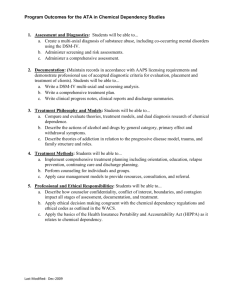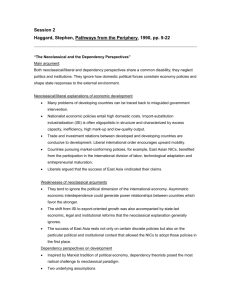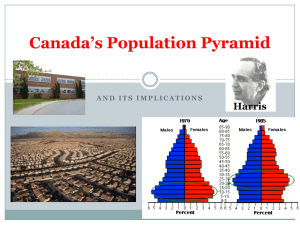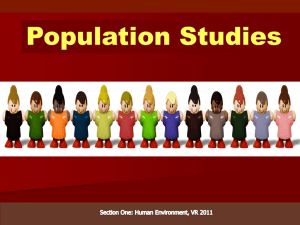FRR-38 Calculation Parameters
advertisement
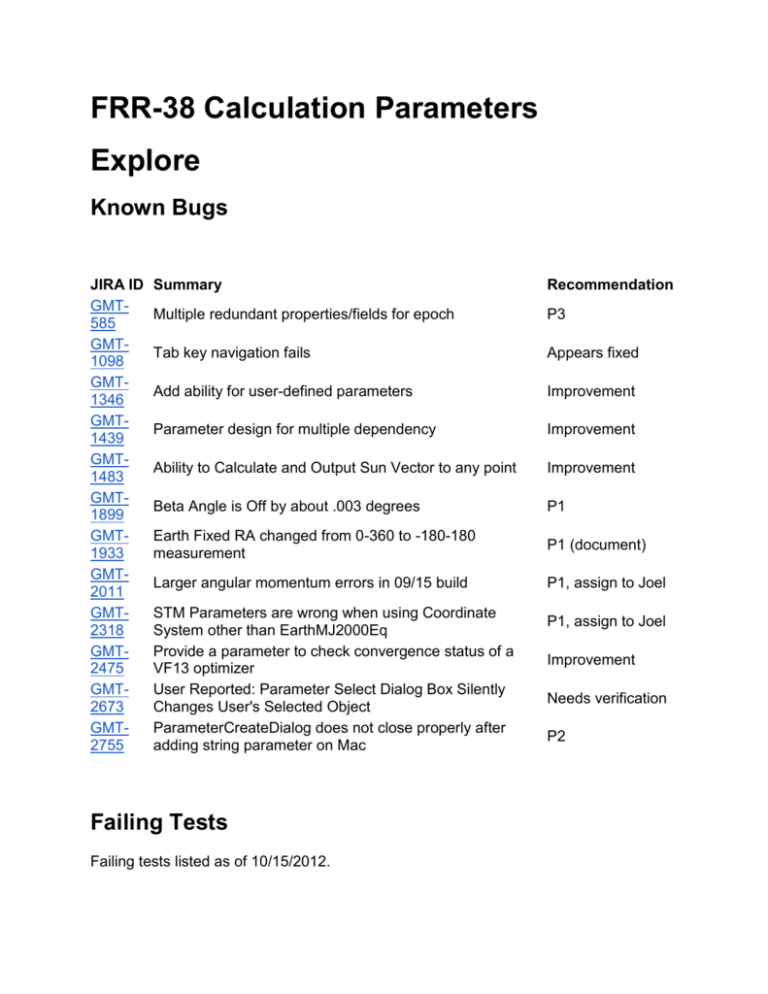
FRR-38 Calculation Parameters
Explore
Known Bugs
JIRA ID
GMT585
GMT1098
GMT1346
GMT1439
GMT1483
GMT1899
GMT1933
GMT2011
GMT2318
GMT2475
GMT2673
GMT2755
Summary
Recommendation
Multiple redundant properties/fields for epoch
P3
Tab key navigation fails
Appears fixed
Add ability for user-defined parameters
Improvement
Parameter design for multiple dependency
Improvement
Ability to Calculate and Output Sun Vector to any point
Improvement
Beta Angle is Off by about .003 degrees
P1
Earth Fixed RA changed from 0-360 to -180-180
measurement
P1 (document)
Larger angular momentum errors in 09/15 build
P1, assign to Joel
STM Parameters are wrong when using Coordinate
System other than EarthMJ2000Eq
Provide a parameter to check convergence status of a
VF13 optimizer
User Reported: Parameter Select Dialog Box Silently
Changes User's Selected Object
ParameterCreateDialog does not close properly after
adding string parameter on Mac
Failing Tests
Failing tests listed as of 10/15/2012.
P1, assign to Joel
Improvement
Needs verification
P2
JIRA
Test
ID
TBD
CbParams_Hyperbolic_2Body
TBD
TBD
CSParams_Uranus1_2Body_UranusFixed
TBD
TBD
TBD
TBD
TBD
Summary
Rec.
Incorrect MA,
Investigate
OrbitPeriod
Numeric issues
Numeric issues
Test issues, plus
CSParams_Pluto1_2Body_PlutoFixed
numerics
Test issues, plus many
CSParams_Neptune1_2Body_NeptuneMJ2000Ec
incorrect parameters
CSParams_Neptune1_2Body_NeptuneFixed
Numeric issues
CSParams_Hyperbolic_2Body
Numeric issues
CSParams_GEO_2Body
Numeric issues
CSParams_Saturn1_2Body_SaturnFixed
Investigate
Investigate
Investigate
Investigate
Investigate
Investigate
Investigate
Other Findings
JIRA ID
GMT3164
GMT3165
GMT3166
GMT3167
GMT3173
GMT3205
Summary
Rec.
Inconsistent naming: RadApo/RadPer and VelApoapsis/RadPeriapsis
P3
ParameterSelectDialog is badly named
P2
ParameterSelectDialog string consistency issues
P3
ParameterSelectDialog doesn't remove item from available list once
chosen
P2
Clarification needed on HA output range
P1
ParameterSelectDialog shouldn't use list box for single-parameter
selection
P3
Requirements
To reviewers: I'm considering removing "or set" and the "(read only)/(read/write)" bits
from the requirements. All of the "write" parameters should already be described on
the requirement for the parent resource.
ID
Requirements
The system shall allow the user to request or set the following object
FRR-38.1.0
properties with respect to any celestial body in FRR-16:
FRR1)
Spacecraft and orbit parameters
38.1.1.0
FRR1.
Altitude (read only)
38.1.1.1
FRR2.
Beta angle (read only)
38.1.1.2
FRR3.
C3 energy (read only)
38.1.1.3
FRR4.
Eccentric anomaly (read/write)
38.1.1.4
FRR5.
Eccentricity (read/write)
38.1.1.5
FRR6.
Orbit energy (read only)
38.1.1.6
FRR7.
Magnitude of angular momentum (read only)
38.1.1.7
FRR8.
Planetodetic latitude (read only)
38.1.1.8
FRR9.
Longitude (read only)
38.1.1.8
FRR10.
Local sidereal time (read only)
38.1.1.10
FRR11.
Mean anomaly (read/write)
38.1.1.11
FRR12.
Mean hour angle (read only)
38.1.1.12
FRR13.
Mean motion (read only)
38.1.1.13
FRR14.
Orbit period (read only)
38.1.1.14
FRR15.
Radius of apoapsis (read/write)
38.1.1.15
FRR16.
Radius of periapsis (read/write)
38.1.1.16
FRR17.
Magnitude of position vector (read/write)
38.1.1.17
FRR38.1.1.18
FRR38.1.1.19
FRR38.1.1.20
FRR38.1.1.21
FRR38.1.1.22
FRR38.1.1.23
FRR38.1.1.24
FRR38.1.1.25
FRR-38.2.0
FRR38.2.1.0
FRR38.2.1.1
FRR38.2.1.2
FRR38.2.1.3
FRR38.2.1.4
FRR38.2.1.5
FRR38.2.1.6
FRR38.2.1.7
FRR38.2.1.8
FRR38.2.1.9
(delete)
FRR38.2.1.11
FRR-
18.
Semilatus rectum (read only)
19.
Semi-major axis (read/write)
20.
True anomaly (read/write)
21.
Velocity at apoapsis (read only)
22.
Velocity at periapsis (read only)
23.
Hyperbolic anomaly (read/write)
24.
Apoapsis crossing indicator (read only)
25.
Periapsis crossing indicator (read only)
The system shall allow the user to request or set the following object
properties with respect to any coordinate system in FRR-35:
1)
Spacecraft and orbit parameters
1.
Argument of periapsis (read/write)
2.
Azimuth (read/write)
3.
B dot T (read only)
4.
B dot R (read only)
5.
B vector angle (read only)
6.
B vector magnitude (read only)
7.
Declination (read/write)
8.
Declination of velocity (read/write)
9.
Flight path angle (read/write)
10.
Hyperbolic anomaly (read/write)
11.
Components of angular momentum (read only)
12.
Inclination (read/write)
38.2.1.12
FRR38.2.1.13
FRR38.2.1.14
FRR38.2.1.15
FRR38.2.1.16
FRR38.2.1.17
FRR38.2.1.18
FRR38.2.1.19
FRR38.2.1.20
FRR38.2.1.21
FRR38.2.1.22
FRR-38.3.0
FRR38.3.1.0
FRR38.3.1.3
FRR38.3.1.4
FRR38.3.1.5
FRR38.3.1.6
FRR38.3.1.7
FRR38.3.1.8
FRR38.3.1.9
FRR38.3.1.10
(delete)
13.
Orbit state transition matrix (read only)
14.
3x3 partitions of Orbit STM (read only)
15.
Right ascension (read/write)
16.
Right ascension of the ascending node (read/write)
17.
Right ascension of velocity (read/write)
18.
Magnitude of velocity (read/write)
19.
Components of Cartesian velocity (read/write)
20.
Components of Cartesian position (read/write)
21.
only)
Right ascension of outgoing hyperbolic asymptote (read
22.
Declination of outgoing hyperbolic asymptote (read only)
The system shall allow the user to request or set the following object
properties:
1)
Spacecraft and orbit parameters
3.
Components of angular velocity (read/write)
4.
Drag coefficient (read/write)
5.
Reflectivity coefficient (read/write)
6.
Components of attitude direction cosine matrix (read/write)
7.
Drag area (read/write)
8.
Dry mass (read/write)
9.
Elapsed days (read only)
10.
Elapsed seconds (read only)
11.
Euler angles for any sequence (read/write)
(delete)
FRR38.3.1.13
FRR38.3.1.14
FRR38.3.1.15
FRR38.3.1.16
FRR38.3.1.19
FRR38.3.1.20
FRR38.3.1.21
FRR38.3.1.22
FRR38.3.1.23
FRR38.3.1.24
FRR38.3.1.25
FRR38.3.1.26
FRR38.3.1.27
FRR38.3.1.28
FRR38.3.1.29
FRR38.3.1.30
FRR38.3.1.31
FRR38.3.2.0
FRR38.3.2.1
FRR38.3.2.2
FRR-
12.
Euler angle rates for any sequence (read/write)
13.
Components of attitude quaternion (read only)
14.
SRP area (read/write)
15.
Epoch in TAI modified Julian (read/write)
16.
Epoch in TAI Gregorian (read/write)
19.
Epoch in TDB modified Julian (read/write)
20.
Epoch in TDB Gregorian (read/write)
21.
Epoch in TT modified Julian (read/write)
22.
Epoch in TT Gregorian (read/write)
23.
Epoch in UTC modified Julian (read/write)
24.
Epoch in UTC Gregorian (read/write)
25.
Total mass (read only)
26.
Modified Rodrigues parameters (read/write)
27.
Euler angles (read/write)
28.
Euler angle rates (read/write)
29.
Epoch in A.1 modified Julian (read/write)
30.
Epoch in A.1 Gregorian (read/write)
31.
Attitude quaternion (read/write)
2)
Impulsive burn parameters
1.
Thrust vector element 1 (read/write)
2.
Thrust vector element 2 (read/write)
3.
Thrust vector element 3 (read/write)
38.3.2.3
(delete)
(delete)
(delete)
FRR38.3.3.0
FRR38.3.3.1
FRR38.3.3.2
FRR38.3.3.3
FRR38.3.3.4
FRR38.3.3.5
FRR38.3.3.6
FRR38.3.4.0
FRR38.3.4.1
FRR38.3.4.2
FRR38.3.4.3
FRR38.3.4.4
FRR38.3.4.5
FRR38.3.4.6
4.
5.
6.
3)
Thrust vector velocity component (read/write)
Thrust vector normal component (read/write)
Thrust vector binormal component (read/write)
Tank parameters
1.
Pressure (read/write)
2.
Volume (read/write)
3.
Fuel density (read/write)
4.
Fuel mass (read/write)
5.
Temperature (read/write)
6.
Reference temperature (read/write)
4)
Thruster parameters
1.
Duty cycle (read/write)
2.
Thrust scale factor (read/write)
3.
Gravitational acceleration for thrust equation (read/write)
4.
Thrust coefficients (read/write)
5.
Isp coefficients (read/write)
6.
Components of thrust direction (read/write)
Interface/Functional Spec
Overview
Data property available for use by commands
Description
Parameters are named resource properties that can be used to obtain data for use by
Mission Sequence commands or by output resources. Some parameters, such as the
Altitude parameter of Spacecraft, are calculated values that can only be used to
retrieve data. They cannot be set directly. Others, such as the Element1 parameter of
ImpulsiveBurn, share the same name as a resource field and can be used both to set
data and retrieve it. Parameters are distinguished from resource fields by their extra
functionality: fields are static resource properties that are usually set in initialization (or
in the GUI Resources tree), while parameters can be calculated on the fly and used in
plots, reports, and mathematical expressions.
Parameters are classified as one of four types: central-body-dependent parameters,
coordinate-system-dependent parameters, attached-hardware parameters, and
standalone parameters. Standalone parameters are the simplest type, in that they have
no dependencies. The ElapsedSecs parameter of Spacecraft is an example of this; it
is simply referenced as Spacecraft.ElapsedSecs.
Central-body-dependent parameters, as the name suggests, have a value that is
dependent on the chosen celestial body. The Altitude parameter of Spacecraft is an
example of this. To reference this parameter, you must specify a central body, such as
Spacecraft.Mars.Altitude. Any built-in central body or user-defined Asteroid, Comet,
Moon, or Planet is valid as a dependency. If the dependency is omitted, Earth is
assumed.
Likewise, coordinate-system-dependent parameters have a value that is dependent on
the chosen coordinate system. The DEC parameter of Spacecraft is an example of this.
To reference this parameter, you must specify the name of a CoordinateSystem
resource, such as Spacecraft.EarthFixed.DEC. Any default or user-defined
CoordinateSystem resource is valid as a dependency. If the dependency is omitted,
EarthMJ2000Eq is assumed.
Attached-hardware parameters have no dependencies, but are themselves dependent
on being attached to a Spacecraft. FuelTank and Thruster parameters are examples
of this. The FuelMass parameter of FuelTank cannot be referenced without first
attaching the FuelTank to a Spacecraft. Then, the parameter can be referenced as:
Spacecraft.FuelTank.FuelMass.
The individual parameters are resource-specific, and are documented along with the
their parent resources. The GUI, however, has a parameter selection interface that is
common to all parameters. This interface is documented in GUI, below.
See Also: Script Language, FuelTank, ImpulsiveBurn, Spacecraft, Thruster
GUI
Parameters can be used as input in several places throughout GMAT, such as the
ReportFile and XYPlot resources and the If/Else, Propagate, and Report commands.
In the GUI, all of these use a common interface called the ParameterSelectDialog that
allows for interactive parameter selection. A basic ParameterSelectDialog window
looks like the following:
The ParameterSelectDialog window is used to build a parameter, along with any
dependencies, for use in a command or resource. Some resources and commands
have different requirements for the types of parameters that can be used, so the
ParameterSelectDialog can take slightly different forms, depending on where it's used.
This section will describe the generic interface, then mention any resource- or
command-specific exceptions.
General Usage
The first step in choosing a parameter is to select the object (or resource) type from the
Object Type list in the upper left. Five types can appear in this list: Spacecraft,
ImpulsiveBurn, Variable, Array, and String.
Once you've selected a type, The Object List box is populated with all existing
resources of that type. Use this list to choose the specific resource you'd like to
reference.
If the Spacecraft type is selected, the Attached Hardware List appears below the
Object List. This list displays any hardware (such as FuelTank resources) attached to
the selected Spacecraft. If the Array type is selected, Row and Col boxes appear. Use
these to specify a row and column to select an individual array element, or check Select
Entire Object to choose the entire array.
Once a resource is selected, the Object Properties list is populated with all available
parameters provided by that resource. Some resources, such as instances of Variable
or Array, are themselves parameters, so this list remains empty.
Parameters with different dependency types are commingled in the Object Properties
list. When you select one, the appropriate dependency (if any) appears below the list.
For example, after selecting the Spacecraft AOP parameter, a Coordinate System list
appears. After selecting the Spacecraft Apoapsis parameter, a Central Body list
appears. And after selecting the Spacecraft Cd parameter, no dependency list
appears. To select a range of parameters from the Object Properties list, hold down
the Shift key while selecting the second endpoint of the range. To select multiple
individual parameters, hold down the Ctrl key while making each selection.
To select a parameter, select the appropriate Object Type, the specific resource from
the Object List or Attached Hardware List, the desired parameter from the Object
Properties list, and the required dependency, and add it to the Selected Value(s) list
on the right. There are six buttons available to control this list:
UP: Move the selected item in the Selected Value(s) list up one position (if
allowed).
DN: Move the selected item in the Selected Value(s) list down one position (if
allowed).
->: Add the selected item in the Object Properties list to the Selected Value(s)
list.
<-: Remove the selected item in the Selected Value(s) list.
=>: Add all items to the Selected Value(s) list.
<=: Remove all items from the Selected Value(s) list.
When finished, the Selected Value(s) list contains the final selected parameters. Click
OK to accept the selection.
The ordering of the Selected Value(s) list is significant in certain circumstances (such
as in the Add field of ReportFile), but not in others. See the documentation for each
resource or command for details.
Special Considerations
Some resources and commands (such as the Propagate command Parameter
argument) only accept a single parameter as input; in this context the
ParameterSelectDialog only allows one parameter in the Selected Value(s) list and
does not allow use of the UP, DN, and => buttons.
In some instances (such as in the Vary command), only parameters that are also fields
(and so can be set in the Mission Sequence) can be used. In this case only the
allowed parameters will be shown in the Object Properties list.
In the Propagate command Parameter argument, only parameters of Spacecraft can
be used. In this case only Spacecraft will be shown in the Object Type list.
Parameters
To Reviewer: These tables will be merged into the parent reference pages and
labeled as "Field" or "Parameter". For existing fields, the description already in the
spec will be used instead of the description below. Each section below will be linked
to the parent reference page.
To Technical Writer: The "pencil" icon in the following tables is from
http://www.famfamfam.com/lab/icons/silk/. They're free to use, but we need to credit
them.
Spacecraft
Parameter
Units
ElapsedSecs
N Y s
ElapsedDays
N Y d
A1ModJulian
Y Y d
Description
Spacecraft
Data Type: Real Number
Dependency: None
Spacecraft
Data Type: Real Number
Dependency: None
Spacecraft orbit epoch in the A.1 system and the
Modified Julian format.
Data Type: Real Number
Dependency: None
Spacecraft orbit epoch in the A.1 system and the
Gregorian format.
A1Gregorian
Y N N/A
Data Type: String
Dependency: None
Spacecraft orbit epoch in the TAI system and the
Modified Julian format.
TAIModJulian
Y Y d
Data Type: Real Number
Dependency: None
The spacecraft orbit epoch in the TAI system and the
Gregorian format.
TAIGregorian
Y N N/A
Data Type: String
Dependency: None
The spacecraft orbit epoch in the TT system and the
Modified Julian format.
TTModJulian
Y Y d
Data Type: Real Number
Dependency: None
Spacecraft orbit epoch in the TT system and the
Gregorian format.
TTGregorian
Y N N/A
Data Type: String
Dependency: None
Spacecraft orbit epoch in the TDB system and the
Modified Julian format.
TDBModJulian
Y Y d
Data Type: Real Number
Dependency: None
Spacecraft orbit epoch in the TDB system and the
Gregorian format.
TDBGregorian
Y N N/A
Data Type: String
Dependency: None
Spacecraft orbit epoch in the UTC system and the
Modified Julian format.
UTCModJulian
Y Y d
Data Type: Real Number
Dependency: None
Spacecraft orbit epoch in the UTC system and the
Gregorian format.
UTCGregorian
CurrA1MJD
Y N N/A
Y Y d
Data Type: String
Dependency: None
Deprecated. Spacecraft orbit epoch in the A.1 system
and the Modified Julian format.
Data Type: Real Number
Dependency: None
Cartesian x-component of the spacecraft position.
X
Y Y km
Y
Y Y km
Z
Y Y km
VX
Y Y km/s
VY
Y Y km/s
VZ
Y Y km/s
SMA
Y Y km
ECC
Y Y N/A
INC
Y Y °
Data Type: Real Number
Dependency: Coordinate System
Cartesian y-component of the spacecraft position.
Data Type: Real Number
Dependency: Coordinate System
Cartesian z-component of the spacecraft position.
Data Type: Real Number
Dependency: Coordinate System
Cartesian x-component of the spacecraft velocity.
Data Type: Real Number
Dependency: Coordinate System
Cartesian y-component of the spacecraft velocity.
Data Type: Real Number
Dependency: Coordinate System
Cartesian z-component of the spacecraft velocity.
Data Type: Real Number
Dependency: Coordinate System
Orbit semi-major axis.
Data Type: Real Number
Dependency: Central Body
Orbit eccentricity.
Data Type: Real Number
Dependency: Central Body
Orbit inclination.
Data Type: Real Number
Dependency: Coordinate System
Output Range: 0° ≤ INC ≤ 180°
Orbit right ascension of the ascending node.
RAAN
Y Y °
Data Type: Real Number
Dependency: Coordinate System
Output Range: 0° ≤ RAAN < 360°
Orbit argument of periapsis.
AOP
Y Y °
Data Type: Real Number
Dependency: Coordinate System
Output Range: 0° ≤ AOP < 360°
True anomaly.
TA
Y Y °
Data Type: Real Number
Dependency: Central Body
Output Range: 0° ≤ TA < 360°
Mean anomaly.
MA
N Y °
Data Type: Real Number
Dependency: Central Body
Output Range: 0° ≤ MA < 360° (elliptic orbits)
Eccentric anomaly.
EA
N Y °
Data Type: Real Number
Dependency: Central Body
Output Range: 0° ≤ EA < 360°
Hyperbolic anomaly.
HA
N Y °
MM
N Y rad/s
VelApoapsis
N Y km/s
VelPeriapsis
N Y km/s
Apoapsis
N Y N/A
Data Type: Real Number
Dependency: Central Body
A parameter that equals zero when the spacecraft is
at orbit apoapsis. This parameter is intended to be
used as a stopping condition in the Propagate
command.
N Y N/A
Data Type: Real Number
Dependency: Central Body
A parameter that equals zero when the spacecraft is
Periapsis
Data Type: Real Number
Dependency: Central Body
Mean motion.
Data Type: Real Number
Dependency: Central Body
Scalar velocity at apoapsis.
Data Type: Real Number
Dependency: Central Body
Scalar velocity at periapsis.
at orbit periapsis. This parameter is intended to be
used as a stopping condition in the Propagate
command.
Data Type: Real Number
Dependency: Central Body
Osculating orbit period.
OrbitPeriod
N Y s
RadApo
Y Y km
Data Type: Real Number
Dependency: Central Body
Radius of apoapsis.
Data Type: Real Number
Dependency: Central Body
Radius of periapsis.
RadPer
Y Y km
C3Energy
N Y
MJ/kg
(km2/s2)
Energy
N Y
MJ/kg
(km2/s2)
RMAG
Y Y km
RA
Y Y °
Data Type: Real Number
Dependency: Coordinate System
Output Range: -180° ≤ RA ≤ 180°
Declination of the orbital position.
DEC
Y Y °
Data Type: Real Number
Dependency: Coordinate System
Output Range: -90° ≤ DEC ≤ 90°
Magnitude of the orbital velocity vector.
VMAG
Y Y km/s
Data Type: Real Number
Dependency: Central Body
C3 (characteristic) energy.
Data Type: Real Number
Dependency: Central Body
Specific orbital energy.
Data Type: Real Number
Dependency: Central Body
Magnitude of the orbital position vector.
Data Type: Real Number
Dependency: Central Body
Right ascension of the orbital position.
Data Type: Real Number
Dependency: Coordinate System
Right ascension of orbital velocity.
RAV
Y Y °
Data Type: Real Number
Dependency: Coordinate System
Output Range: -180° ≤ RAV ≤ 180°
Declination of orbital velocity.
DECV
Y Y °
Data Type: Real Number
Dependency: Coordinate System
Output Range: -90° ≤ DECV ≤ 90°
Orbital velocity azimuth.
AZI
Y Y °
Data Type: Real Number
Dependency: Coordinate System
Output Range: -180° ≤ AZI ≤ 180°
Orbital flight path angle.
FPA
Y Y °
Data Type: Real Number
Dependency: Coordinate System
Output Range: 0° ≤ FPA ≤ 180°
Semilatus rectum of the osculating orbit.
SemilatusRectum N Y km
HMAG
N Y km2/s
HX
N Y km2/s
HY
N Y km2/s
HZ
N Y km2/s
DLA
N Y °
Data Type: Real Number
Dependency: Central Body
Magnitude of the angular momentum vector.
Data Type: Real Number
Dependency: Central Body
X component of the angular momentum vector.
Data Type: Real Number
Dependency: Coordinate System
Y component of the angular momentum vector.
Data Type: Real Number
Dependency: Coordinate System
Z component of the angular momentum vector.
Data Type: Real Number
Dependency: Coordinate System
Declination of the outgoing hyperbolic asymptote.
Data Type: Real Number
Dependency: Coordinate System
Output Range: -90° ≤ DLA ≤ 90°
Right ascension of the outgoing hyperbolic
asymptote.
RLA
N Y °
Altitude
N Y km
Data Type: Real Number
Dependency: Coordinate System
Output Range: -180° ≤ RLA ≤ 180°
Distance to the plane tangent to the surface of the
specified celestial body at the sub-satellite point.
GMAT assumes the body is an ellipsoid.
Data Type: Real Number
Dependency: Central Body
Greenwich hour angle.
MHA
N Y °
Data Type: Real Number
Dependency: Central Body
Output Range: 0° ≤ MHA < 360°
Planetodetic longitude.
Longitude
N Y °
Data Type: Real Number
Dependency: Central Body
Output Range: -180° ≤ Longitude ≤ 180°
Planetodetic latitude.
Latitude
N Y °
Data Type: Real Number
Dependency: Central Body
Output Range: -90° ≤ Latitude ≤ 90°
Local sidereal time.
LST
N Y °
Data Type: Real Number
Dependency: Central Body
Output Range: 0° ≤ LST < 360°
Beta angle (or phase angle) between the orbit normal
vector and the vector from the celestial body to the
sun.
BetaAngle
N Y °
Data Type: Real Number
Dependency: Central Body
Output Range: -90° ≤ BetaAngle ≤ 90°
B-plane B·T magnitude.
BdotT
N Y km
Data Type: Real Number
Dependency: Coordinate System
B-plane B·R magnitude.
BdotR
N Y km
BVectorMag
N Y km
BVectorAngle
N Y °
DCM11
Y Y (None)
DCM12
Y Y (None)
DCM13
Y Y (None)
DCM21
Y Y (None)
DCM22
Y Y (None)
DCM23
Y Y (None)
DCM31
Y Y (None)
Data Type: Real Number
Dependency: Coordinate System
B-plane B vector magnitude.
Data Type: Real Number
Dependency: Coordinate System
B-plane angle between the B vector and the T unit
vector.
Data Type: Real Number
Dependency: Coordinate System
Output Range: -180° ≤ BVectorAngle ≤ 180°
Element (1,1) of the attitude direction cosine matrix.
Data Type: Real Number
Dependency: (None)
Element (1,2) of the attitude direction cosine matrix.
Data Type: Real Number
Dependency: (None)
Element (1,3) of the attitude direction cosine matrix.
Data Type: Real Number
Dependency: (None)
Element (2,1) of the attitude direction cosine matrix.
Data Type: Real Number
Dependency: (None)
Element (2,2) of the attitude direction cosine matrix.
Data Type: Real Number
Dependency: (None)
Element (2,3) of the attitude direction cosine matrix.
Data Type: Real Number
Dependency: (None)
Element (3,1) of the attitude direction cosine matrix.
Data Type: Real Number
Dependency: (None)
Element (3,2) of the attitude direction cosine matrix.
DCM32
Y Y (None)
DCM33
Y Y (None)
EulerAngle1
Y Y °
Data Type: Real Number
Dependency: (None)
Output Range: 0° ≤ EulerAngle1 < 360°
Attitude Euler angle 2.
EulerAngle2
Y Y °
Data Type: Real Number
Dependency: (None)
Output Range: 0° ≤ EulerAngle2 < 360°
Attitude Euler angle 3.
EulerAngle3
Y Y °
Data Type: Real Number
Dependency: (None)
Output Range: 0° ≤ EulerAngle3 < 360°
Attitude modified Rodrigues parameter 1.
MRP1
Y Y (None)
MRP2
Y Y (None)
MRP3
Y Y (None)
Q1
N Y (None)
Q2
N Y (None)
Data Type: Real Number
Dependency: (None)
Element (3,3) of the attitude direction cosine matrix.
Data Type: Real Number
Dependency: (None)
Attitude Euler angle 1.
Data Type: Real Number
Dependency: (None)
Attitude modified Rodrigues parameter 2.
Data Type: Real Number
Dependency: (None)
Attitude modified Rodrigues parameter 3.
Data Type: Real Number
Dependency: (None)
Attitude quaternion element 1 (a).
Data Type: Real Number
Dependency: (None)
Attitude quaternion element 2 (b).
Data Type: Real Number
Dependency: (None)
Attitude quaternion element 3 (c).
Q3
N Y (None)
Q4
N Y (None)
Quaternion
Y N (None)
AngularVelocityX Y Y °/s
AngularVelocityY Y Y °/s
AngularVelocityZ Y Y °/s
EulerAngleRate1 Y Y °/s
EulerAngleRate2 Y Y °/s
EulerAngleRate3 Y Y °/s
DryMass
Y Y kg
Cd
Y Y (None)
Data Type: Real Number
Dependency: (None)
Attitude quaternion element 4 (d).
Data Type: Real Number
Dependency: (None)
Attitude quaternion.
Data Type: Array (1×4)
Dependency: (None)
X component of the attitude angular velocity vector.
Data Type: Real Number
Dependency: (None)
Y component of the attitude angular velocity vector.
Data Type: Real Number
Dependency: (None)
Z component of the attitude angular velocity vector.
Data Type: Real Number
Dependency: (None)
Rate of attitude Euler angle 1.
Data Type: Real Number
Dependency: (None)
Rate of attitude Euler angle 2.
Data Type: Real Number
Dependency: (None)
Rate of attitude Euler angle 3.
Data Type: Real Number
Dependency: (None)
Dry mass (without propellant).
Data Type: Real Number
Dependency: (None)
Coefficient of drag.
Data Type: Real Number
Dependency: (None)
Coefficient of reflectivity.
Cr
Y Y (None)
DragArea
Y Y m2
Data Type: Real Number
Dependency: (None)
Area used to compute acceleration due to
atmospheric drag.
Data Type: Real Number
Dependency: (None)
Area used to compute acceleration due to solar
radiation pressure.
SRPArea
Y Y m2
Data Type: Real Number
Dependency: (None)
Total mass, including fuel mass from attached Fuel
Tank resources.
TotalMass
N Y kg
Data Type: Real Number
Dependency: (None)
State transition matrix.
OrbitSTM
N N (None)
OrbitSTMA
N N (None)
OrbitSTMB
N N (None)
OrbitSTMC
N N (None)
OrbitSTMD
N N (None)
Data Type: Array (6×6)
Dependency: Coordinate System
Upper-left quadrant of the state transition matrix.
Data Type: Array (3×3)
Dependency: Coordinate System
Upper-right quadrant of the state transition matrix.
Data Type: Array (3×3)
Dependency: Coordinate System
Lower-left quadrant of the state transition matrix.
Data Type: Array (3×3)
Dependency: Coordinate System
Lower-right quadrant of the state transition matrix.
Data Type: Array (3×3)
Dependency: Coordinate System
FuelTank
Parameter
Units Description
Mass of fuel in the tank.
FuelMass
Y Y kg
Volume
Y Y m3
Data Type: Real Number
Dependency: (None)
Volume of the tank. GMAT checks to ensure that the input
volume of the tank is larger than the calculated volume of
fuel loaded in the tank and throws an exception in the case
that the calculated fuel volume is larger than the input tank
volume.
Data Type: Real Number
Dependency: (None)
Density of the fuel.
FuelDensity
Y Y kg/m3
Pressure
Y Y kPa
Temperature
Y Y °C
Data Type: Real Number
Dependency: (None)
Pressure in the tank.
Data Type: Real Number
Dependency: (None)
Temperature of the fuel and ullage in the tank. GMAT
currently assumes ullage and fuel are always at the same
temperature.
Data Type: Real Number
Dependency: (None)
The temperature of the tank when fuel was loaded.
RefTemperature Y Y °C
Data Type: Real Number
Dependency: (None)
Thruster
Parameter
DutyCycle
Units
Description
Fraction of time that the thrusters are on during a
maneuver. The thrust applied to the spacecraft is
scaled by this amount. Note that this scale factor also
Y Y (None) affects mass flow rate.
Data Type: Real Number
Dependency: (None)
Scale factor that is multiplied by the thrust vector, for
ThrustScaleFactor Y Y (None) a given thruster, before the thrust vector is added into
the total acceleration. Note that the value of this scale
factor does not affect the mass flow rate.
Data Type: Real Number
Dependency: (None)
Value of the gravitational acceleration used for the
FuelTank/Thruster calculations.
GravitationalAccel Y Y m/s2
Data Type: Real Number
Dependency: (None)
Thrust coefficient C1.
C1
Y Y N
C2
Y Y N/kPa
C3
Y Y N
C4
Y Y N/kPa
C5
Y Y N/kPa2
C6
Y Y N/kPaC7
C7
Y Y (None)
C8
Y Y N/kPaC9
C9
Y Y (None)
Data Type: Real Number
Dependency: (None)
Thrust coefficient C2.
Data Type: Real Number
Dependency: (None)
Thrust coefficient C3.
Data Type: Real Number
Dependency: (None)
Thrust coefficient C4.
Data Type: Real Number
Dependency: (None)
Thrust coefficient C5.
Data Type: Real Number
Dependency: (None)
Thrust coefficient C6.
Data Type: Real Number
Dependency: (None)
Thrust coefficient C7.
Data Type: Real Number
Dependency: (None)
Thrust coefficient C8.
Data Type: Real Number
Dependency: (None)
Thrust coefficient C9.
Data Type: Real Number
Dependency: (None)
Thrust coefficient C10.
C10
Y Y N/kPaC11
C11
Y Y (None)
C12
Y Y N
C13
Y Y (None)
C14
Y Y 1/kPa
C15
Y Y (None)
C16
Y Y 1/kPa
K1
Y Y s
K2
Y Y s/kPa
K3
Y Y s
K4
Y Y s/kPa
Data Type: Real Number
Dependency: (None)
Thrust coefficient C11.
Data Type: Real Number
Dependency: (None)
Thrust coefficient C12.
Data Type: Real Number
Dependency: (None)
Thrust coefficient C13.
Data Type: Real Number
Dependency: (None)
Thrust coefficient C14.
Data Type: Real Number
Dependency: (None)
Thrust coefficient C15.
Data Type: Real Number
Dependency: (None)
Thrust coefficient C16.
Data Type: Real Number
Dependency: (None)
Isp coefficient K1.
Data Type: Real Number
Dependency: (None)
Isp coefficient K2.
Data Type: Real Number
Dependency: (None)
Isp coefficient K3.
Data Type: Real Number
Dependency: (None)
Isp coefficient K4.
Data Type: Real Number
Dependency: (None)
Isp coefficient K5.
K5
Y Y s/kPa2
K6
Y Y s/kPaC7
K7
Y Y (None)
K8
Y Y s/kPaC9
K9
Y Y (None)
K10
Y Y s/kPaC11
K11
Y Y (None)
K12
Y Y s
K13
Y Y (None)
K14
Y Y 1/kPa
K15
Y Y (None)
Data Type: Real Number
Dependency: (None)
Isp coefficient K6.
Data Type: Real Number
Dependency: (None)
Isp coefficient K7.
Data Type: Real Number
Dependency: (None)
Isp coefficient K8.
Data Type: Real Number
Dependency: (None)
Isp coefficient K9.
Data Type: Real Number
Dependency: (None)
Isp coefficient K10.
Data Type: Real Number
Dependency: (None)
Isp coefficient K11.
Data Type: Real Number
Dependency: (None)
Isp coefficient K12.
Data Type: Real Number
Dependency: (None)
Isp coefficient K13.
Data Type: Real Number
Dependency: (None)
Isp coefficient K14.
Data Type: Real Number
Dependency: (None)
Isp coefficient K15.
Data Type: Real Number
Dependency: (None)
Isp coefficient K16.
K16
Y Y 1/kPa
ThrustDirection1
Y Y (None)
ThrustDirection2
Y Y (None)
ThrustDirection3
Y Y (None)
Data Type: Real Number
Dependency: (None)
ThrustDirection1, divided by the RSS of the three
direction components, forms the x component of the
spacecraft thrust vector direction.
Data Type: Real Number
Dependency: (None)
ThrustDirection2, divided by the RSS of the three
direction components, forms the y component of the
spacecraft thrust vector direction.
Data Type: Real Number
Dependency: (None)
ThrustDirection3, divided by the RSS of the three
direction components, forms the z component of the
spacecraft thrust vector direction.
Data Type: Real Number
Dependency: (None)
ImpulsiveBurn
Parameter
Units Description
X-component of the applied impulsive burn (delta-V).
Element1 Y Y (None)
Element2 Y Y (None)
Element3 Y Y (None)
V
Data Type: Real Number
Dependency: (None)
Y-component of the applied impulsive burn (delta-V).
Data Type: Real Number
Dependency: (None)
Z-component of the applied impulsive burn (delta-V).
Data Type: Real Number
Dependency: (None)
Deprecated. Velocity component of the applied impulsive burn
(delta-V).
Y Y (None)
Data Type: Real Number
Dependency: (None)
Deprecated. Normal component of the applied impulsive burn
(delta-V).
N
Y Y (None)
Data Type: Real Number
Dependency: (None)
Deprecated. Binormal component of the applied impulsive burn
(delta-V).
B
Y Y (None)
Data Type: Real Number
Dependency: (None)
Array, String, Variable
Array, String, and Variable resources are themselves parameters, and can be used as
any other parameter would. All of these are writable parameters, though only Variable
resources and individual elements of Array resources can be plotted.
Examples
Using parameters in the Mission Sequence:
Create Spacecraft aSat
Create Propagator aProp
Create ReportFile aReport
BeginMissionSequence
% propagate for 100 steps
For i=1:100
Propagate aProp(aSat)
% write four parameters (one standalone, three coordinate-system-dependent) to
a file
Report aReport aSat.TAIGregorian aSat.EarthFixed.X aSat.EarthFixed.Y
aSat.EarthFixed.Z
EndFor
Using parameters as plot data:
Create Spacecraft aSat
Create Propagator aProp
Create XYPlot aPlot
aPlot.XVariable = aSat.TAIModJulian
aPlot.YVariables = {aSat.Earth.Altitude, aSat.Earth.ECC}
BeginMissionSequence
% propagate for 100 steps
For i=1:100
Propagate aProp(aSat)
EndFor
Using parameters as stopping conditions:
Create Spacecraft aSat
aSat.SMA = 6678
Create ForceModel anFM
anFM.Drag.AtmosphereModel = MSISE90
Create Propagator aProp
aProp.FM = anFM
BeginMissionSequence
Propagate aProp(aSat) {aSat.Earth.Altitude = 100, aSat.ElapsedDays = 365}
Test Procedures
I generated truth data using STK 9 through the STK Object Model. These scripts are
located in extern\Resources\FRR-38_CalculationParameters\stk. I matched data
between the two tools as follows:
1. Central-body physical properties (mu, radii) are configured in the STK .cb files in
the scenario directory, based on default GMAT data.
2. I used EOP data for GMAT and STK from 2012-10-30. I had to replace the
default application-wide data for each tool.
3. Some mu values are hard-coded in the GMAT and STK scripts. These are all set
to the GMAT default mu values.
The following table lists all available parameters and where each is tested (if at all).
Calculation tests are tests that perform some calculation that affects the parameter.
Read tests check that the parameter can be read in a script. Write tests check that the
parameter can be assigned to in the Mission Sequence.
If a script name appears in a column, the parameter is tested as a part of the
Calculation Parameters tests (specifically in the named script). If another requirement
appears, then the parameter is being tested as a part of the test suite for that
requirement. If (N/A) appears, that test type does not apply to the parameter. A (
)
indicates that the parameter is not currently being tested, and that it should be tested as
a part of the Calculation Parameters tests unless another requirement is listed
afterwards.
There is an assumption being made that the ability to plot plottable parameters is being
tested as part of XYPlot QA.
Even if a parameter has a test name listed, it needs work until the following are true:
central-body parameters are tested using:
central body of the Spacecraft CoordinateSystem
another planet (Venus or Earth)
Luna (or another planet)
user-defined body (UserMars or UserSaturn)
coordinate-system parameters are tested using:
o Spacecraft CoordinateSystem
o EarthMJ2000Eq (or Venus)
o EarthFixed
o user-created body-fixed (central body of the Spacecraft CoordinateSystem
or Saturn)
o
o
o
o
All tests that need work by any of the above criteria are highlighted red in the table.
Finished tests are highlighted green.
Parameter
ElapsedSecs
ElapsedDays
A1ModJulian
A1Gregorian
TAIModJulian
TAIGregorian
TTModJulian
TTGregorian
TDBModJulian
TDBGregorian
UTCModJulian
UTCGregorian
CurrA1MJD
X
Y
Z
VX
VY
VZ
SMA
ECC
INC
RAAN
AOP
TA
MA
Calculation Tests
SpacecraftElapsedTimeParams
SpacecraftElapsedTimeParams
FRR-2
FRR-2
FRR-2
FRR-2
FRR-2
FRR-2
FRR-2
FRR-2
FRR-2
FRR-2
FRR-2
FRR-1
FRR-1
FRR-1
FRR-1
FRR-1
FRR-1
FRR-1
FRR-1
FRR-1
FRR-1
FRR-1
FRR-1
CbParams_*_2Body_*
Read Tests
SpacecraftElapsedTimeParams
SpacecraftElapsedTimeParams
FRR-2
FRR-2
FRR-2
FRR-2
FRR-2
FRR-2
FRR-2
FRR-2
FRR-2
FRR-2
FRR-2
FRR-1
FRR-1
FRR-1
FRR-1
FRR-1
FRR-1
FRR-1
FRR-1
FRR-1
FRR-1
FRR-1
FRR-1
CbParams_*_2Body_*
CbParams_GEO_*
EA
HA
MM
VelApoapsis
VelPeriapsis
Apoapsis
Periapsis
OrbitPeriod
RadApo
RadPer
C3Energy
CbParams_*_2Body_*
CbParams_GEO_*
CBParams_Earth_EA
CbParams_GEO_*
CbParams_*_2Body_*
CbParams_GEO_*
CbParams_*_2Body_*
CbParams_GEO_*
CBParams_Earth_EA
CbParams_*_2Body_*
CbParams_GEO_*
HyperbolicAnomaly_Valid
CBParams_Earth_MM
CbParams_*_2Body_*
CbParams_GEO_*
CbParams_*_2Body_*
CbParams_GEO_*
HyperbolicAnomaly_Valid
CBParams_Earth_MM
CbParams_*_2Body_*
CbParams_GEO_*
CbParams_*_2Body_*
CbParams_GEO_*
CBParams_Earth_VelApoapsis
CbParams_*_2Body_*
CbParams_GEO_*
CBParams_Earth_VelApoapsis
CbParams_*_2Body_*
CbParams_GEO_*
CBParams_Earth_VelPeriapsis
FRC-10
FRC-10
CbParams_*_2Body_*
CbParams_GEO_*
FRR-1
FRR-1
CbParams_*_2Body_*
CbParams_GEO_*
CBParams_Earth_VelPeriapsis
FRC-10
FRC-10
CbParams_*_2Body_*
CbParams_GEO_*
FRR-1
FRR-1
CbParams_*_2Body_*
CbParams_GEO_*
CBParams_Earth_OrbitEnergy
Energy
CBParams_Earth_OrbitEnergy
CbParams_*_2Body_*
CbParams_GEO_*
RMAG
RA
DEC
VMAG
RAV
DECV
AZI
FPA
SemilatusRectum
FRR-1
FRR-1
FRR-1
FRR-1
FRR-1
FRR-1
FRR-1
FRR-1
CbParams_*_2Body_*
CbParams_*_2Body_*
CbParams_GEO_*
FRR-1
FRR-1
FRR-1
FRR-1
FRR-1
FRR-1
FRR-1
FRR-1
CbParams_*_2Body_*
CbParams_GEO_*
CbParams_GEO_*
BdotT
BdotR
BVectorMag
BVectorAngle
CBParams_Earth_SemiLatusRectum CBParams_Earth_SemiLatusRectum
CbParams_*_2Body_*
CbParams_*_2Body_*
CbParams_GEO_*
CbParams_GEO_*
CSParams_*_2Body
CSParams_*_2Body
CSParams_*_2Body_*
CSParams_*_2Body_*
CSParams_*_2Body
CSParams_*_2Body
CSParams_*_2Body_*
CSParams_*_2Body_*
CSParams_*_2Body
CSParams_*_2Body
CSParams_*_2Body_*
CSParams_*_2Body_*
SelectedHyperbolicParams_*
SelectedHyperbolicParams_*
SelectedHyperbolicParams_*
SelectedHyperbolicParams_*
CbParams_*_2Body_*
CbParams_*_2Body_*
CbParams_GEO_*
CbParams_GEO_*
CbParams_*_2Body_*
CbParams_*_2Body_*
CbParams_GEO_*
CbParams_GEO_*
CbParams_*_2Body_*
CbParams_*_2Body_*
CbParams_GEO_*
CbParams_GEO_*
CbParams_*_2Body_*
CbParams_*_2Body_*
CbParams_GEO_*
CbParams_GEO_*
CbParams_*_2Body_*
CbParams_*_2Body_*
CbParams_GEO_*
CbParams_GEO_*
CbParams_*_2Body_*
CbParams_*_2Body_*
CbParams_GEO_*
CbParams_GEO_*
SelectedHyperbolicParams_*
SelectedHyperbolicParams_*
SelectedHyperbolicParams_*
SelectedHyperbolicParams_*
SelectedHyperbolicParams_*
SelectedHyperbolicParams_*
SelectedHyperbolicParams_*
SelectedHyperbolicParams_*
DCM11
FRR-3
FRR-3
DCM12
FRR-3
FRR-3
DCM13
FRR-3
FRR-3
DCM21
FRR-3
FRR-3
DCM22
FRR-3
FRR-3
DCM23
FRR-3
FRR-3
HMAG
HX
HY
HZ
DLA
RLA
Altitude
MHA
Longitude
Latitude
LST
BetaAngle
DCM31
FRR-3
FRR-3
DCM32
FRR-3
FRR-3
DCM33
FRR-3
FRR-3
EulerAngle1
FRR-3
FRR-3
EulerAngle2
FRR-3
FRR-3
EulerAngle3
FRR-3
FRR-3
MRP1
FRR-3
FRR-3
MRP2
FRR-3
FRR-3
MRP3
FRR-3
FRR-3
Q1
Q2
Q3
Q4
FRR-3
FRR-3
FRR-3
FRR-3
FRR-3
FRR-3
FRR-3
FRR-3
Quaternion
(FRR-3)
(FRR-3)
AngularVelocityX
FRR-3
FRR-3
AngularVelocityY
FRR-3
FRR-3
AngularVelocityZ
FRR-3
FRR-3
EulerAngleRate1
FRR-3
FRR-3
EulerAngleRate2
FRR-3
FRR-3
EulerAngleRate3
FRR-3
FRR-3
DryMass
Cd
Cr
DragArea
SRPArea
TotalMass
(N/A)
(N/A)
(N/A)
(N/A)
(N/A)
FRR-11
SpacecraftPhysicalParams
SpacecraftPhysicalParams
SpacecraftPhysicalParams
SpacecraftPhysicalParams
SpacecraftPhysicalParams
FRR-11
OrbitSTM
OrbitSTMA
OrbitSTMB
OrbitSTMC
OrbitSTMD
FuelTank.FuelMass
FuelTank.Volume
FuelTank.FuelDensity
FuelTank.Pressure
FuelTank.Temperature
FRR-9
FRR-13
Params_STMSubsets_*
Params_STMSubsets_*
Params_STMSubsets_*
Params_STMSubsets_*
FRR-11
FRR-9
(FRR-8)
(N/A)
(FRR-8)
(N/A)
FuelTank.RefTemperature (N/A)
Thruster.DutyCycle
(N/A)
Thruster.ThrustScaleFactor (N/A)
Thruster.GravitationalAccel (N/A)
Thruster.C1
(N/A)
Thruster.C2
(N/A)
Thruster.C3
(N/A)
Thruster.C4
(N/A)
Thruster.C5
(N/A)
Thruster.C6
(N/A)
Thruster.C7
(N/A)
Thruster.C8
(N/A)
Thruster.C9
(N/A)
Thruster.C10
(N/A)
Thruster.C11
(N/A)
Thruster.C12
(N/A)
Thruster.C13
(N/A)
Thruster.C14
(N/A)
Thruster.C15
(N/A)
Thruster.C16
(N/A)
Thruster.K1
(N/A)
Thruster.K2
(N/A)
FRR-9
FRR-13
Params_STMSubsets_*
Params_STMSubsets_*
Params_STMSubsets_*
Params_STMSubsets_*
TankParams
ReportSatHardware
TankParams
ReportSatHardware
TankParams
ReportSatHardware
TankParams
ReportSatHardware
TankParams
ReportSatHardware
TankParams
ReportSatHardware
ReportSatHardware
ReportSatHardware
ReportSatHardware
ReportSatHardware
ReportSatHardware
ReportSatHardware
ReportSatHardware
ReportSatHardware
ReportSatHardware
ReportSatHardware
ReportSatHardware
ReportSatHardware
ReportSatHardware
ReportSatHardware
ReportSatHardware
ReportSatHardware
ReportSatHardware
ReportSatHardware
ReportSatHardware
ReportSatHardware
ReportSatHardware
Thruster.K3
Thruster.K4
Thruster.K5
Thruster.K6
Thruster.K7
Thruster.K8
Thruster.K9
Thruster.K10
Thruster.K11
Thruster.K12
Thruster.K13
Thruster.K14
Thruster.K15
Thruster.K16
Thruster.ThrustDirection1
Thruster.ThrustDirection2
Thruster.ThrustDirection3
ImpulsiveBurn.Element1
ImpulsiveBurn.Element2
ImpulsiveBurn.Element3
ImpulsiveBurn.V
ImpulsiveBurn.N
ImpulsiveBurn.B
(N/A)
(N/A)
(N/A)
(N/A)
(N/A)
(N/A)
(N/A)
(N/A)
(N/A)
(N/A)
(N/A)
(N/A)
(N/A)
(N/A)
(N/A)
(N/A)
(N/A)
(N/A)
(N/A)
(N/A)
(N/A)
(N/A)
(N/A)
ReportSatHardware
ReportSatHardware
ReportSatHardware
ReportSatHardware
ReportSatHardware
ReportSatHardware
ReportSatHardware
ReportSatHardware
ReportSatHardware
ReportSatHardware
ReportSatHardware
ReportSatHardware
ReportSatHardware
ReportSatHardware
ReportSatHardware
ReportSatHardware
ReportSatHardware
ImpulsiveBurnParams_VNB_Elemen
ImpulsiveBurnParams_VNB_Elemen
ImpulsiveBurnParams_VNB_Elemen
ImpulsiveBurnParams_VNB_VNBCo
ImpulsiveBurnParams_VNB_VNBCo
ImpulsiveBurnParams_VNB_VNBCo
Edge/Corner/Stress
Priority Status Summary
Test parameters after setting epoch manually, instead of through
propagation.
Unique Validation
Priority Status Summary
Set non-settable params
Set param w/ dependency
Read w/ incorrect dependency type
Set w/ incorrect data type
Set/get w/ incorrect parent (attached hardware)
Set/get w/ incorrect resource type
Plot non-plottable params
Unique Mode Tests
Priority Status Summary
Unique GUI Tests
These are tests that are unique to the GUI interface for this feature that are not covered
by the standard GUI test template and procedures.
Priority Status Summary
Contents:
Explore
o Known Bugs
o Failing Tests
o Other Findings
Requirements
Interface/Functional Spec
o Overview
o Description
o GUI
General Usage
o
Special Considerations
Parameters
Spacecraft
FuelTank
Thruster
ImpulsiveBurn
Array, String, Variable
o Examples
Test Procedures
o Edge/Corner/Stress
o
Unique Validation
o Unique Mode Tests
o Unique GUI Tests
